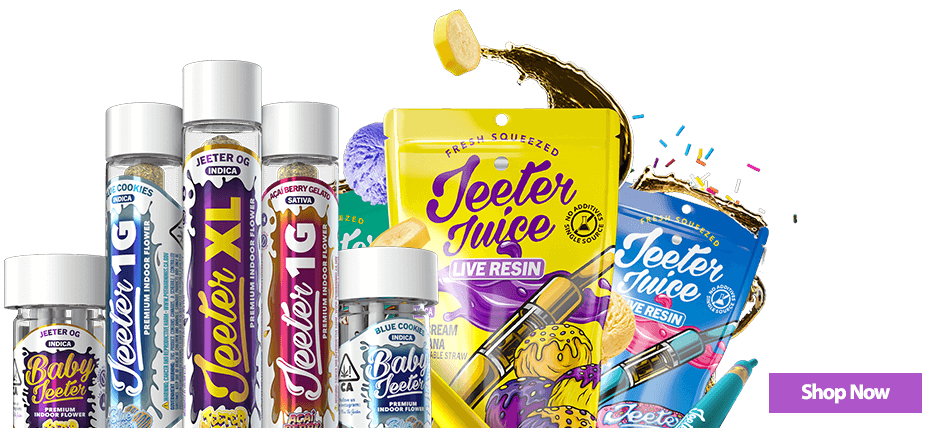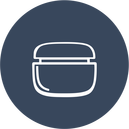Topicals
Topical CBD products have become increasingly popular during the last few years. They serve as an alternative to to taking CBD orally, and in some cases have been more effective than oral intake.
What Exactly Are Cannabis Topicals?
A cannabis product is referred to as "topical" if it is meant for application to the skin. Cannabinoids and other components of cannabis can only be taken into circulation by inhalation or ingestion (except for transdermal patches). Cannabinoid topicals, on the other hand, can carry out their functions because they bypass the circulatory system entirely and deliver the active substances to the skin receptors in this manner.
Cannabis may be topically used in oils, balms, and salves. The subsequent absorption of topical cannabis analgesics into the skin lowers the pain, irritation, and inflammation in the targeted area. People interested in the medicinal advantages of marijuana but do not want to experience the euphoric high that is sometimes associated with smoking or eating cannabis frequently utilize marijuana topicals.
%20(1).jpg?1672171809158)
Users seeking medicinal relief or recreational highs now have access to long-lasting patches and tingly lubricants made possible by cutting-edge transdermal technology that is flooding the cannabis market. When processing marijuana for use in topical preparations, manufacturers make a point of looking for cannabinoid and terpene profiles that are similar to those of Blackberry or any other strain. In addition to THC, CBD, THCA, and other cannabinoids, makers of marijuana topicals may choose other chemicals and essential oils for further therapy. Some examples are cayenne, wintergreen, and clove, but there are many more.
How Cannabis Topicals Work
Cannabis topicals act as lubricants, which makes it easier for the substance to permeate the skin. On the other hand, the therapy that they receive is far more comprehensive. Cannabis topicals allow the body to absorb its active elements through the skin, which then enters the bloodstream. After being consumed, they travel throughout the body and connect to specific cannabinoid receptors.
This process is known as systemic absorption. Within an hour, you ought to be able to observe the benefits of applying a topical. You might attempt to use a cannabis product containing THC, CBD, and terpenes from other plants (aromatic and flavor compounds). In addition to this, a pure CBD isolate product may also be purchased. Products that are equipped with a plethora of helpful features are deserving of their title.
They supply a concentrated version of all the beneficial components that the plant naturally produces. On the other hand, when CBD is separated from the rest of the cannabis plant, the medicinal effects of CBD are reduced since there are no other cannabinoids present to complement them. The fact that topicals manufactured from CBD or hemp do not need a prescription from a doctor is another significant distinction between the two forms of treatment. In certain areas, obtaining a medical marijuana card and a doctor's recommendation is required before you buy any product that includes THC.
Cannabinoid Receptors: What Do They Do?
Epidermal cells and sensory neurons in the skin are where primary cannabinoid receptors CB1 and CB2 are located in the highest concentrations. These receptors can influence skin issues, including itching, inflammation, and discomfort. Cannabinoid receptors are another component of epidermal mast cells, which play a role in the skin's inflammatory and allergic reactions.
In terms of homeostasis, often known as preserving a state of balance between the body's numerous systems, CB1 receptors play an essential part in controlling pain and a great deal of other bodily processes. They are also the receptors responsible for the high that one gets from smoking or ingesting marijuana. However, topical methods circumvent this issue entirely.
Inflammation and pain are both under the control of the CB2 receptor, which plays a role in their regulation. Cannabinoids included in marijuana topical treatments are absorbed via the skin, which then attaches to cannabinoid receptors to produce the desired effects. Similarly, different topicals elicit a variety of responses from the skin. To get the same "high" from the active THC in marijuana topicals as you would from smoking or swallowing the drug, you will need to consume the medication orally. Most cannabinoids in marijuana topicals are not absorbed by the body and hence can only give limited relief.
What Exactly Are Transdermal Cannabis Patches?
Patches that are put topically and progressively deliver a tiny quantity of cannabinoids into the bloodstream through the skin are known as transdermal patches (epidermis and dermis). Even though it seems to be a brand-new technique, this approach has been around for quite some time. Nicotine patches, for example, assist smokers in quitting by continually administering a low quantity of nicotine straight to circulation.
How Effective Are Topical Cannabis Products?
This problem or query frequently comes up among people considering using cannabis topicals. Unfortunately, the response to this request is no. Even though cannabis topicals include THC, using them will not make you high since the THC and other components in the topical will not reach your bloodstream.
When placed on the skin, transdermal patches enable the transfer of these molecules directly into the circulation, where they have the potential to generate euphoria when combined with THC. On the other hand, the effects of a typical high from cannabis are not comparable to those of a high from THC-free transdermal patches.
A physiological mechanism known as the endocannabinoid system is present in all living things, including humans (ECS). It is found in every part of the body. It has been hypothesized to have a mediating function in processes such as the proliferation, development, and differentiation of skin cells, as well as the production of hormones and inflammation.

The endocannabinoid system is essential to the regulation of a wide variety of various body activities. Cannabis topicals can transport cannabinoids and terpenes to the endocannabinoid system's receptors, which are also located in the skin. Because skin receptors have the potential to interact with the chemicals that cannabis plants naturally produce, the use of cannabis topicals may be an effective strategy to increase this interaction. Utilizing cannabis in a topical form has several advantages, including:
- There is a diminishing of the redness, dryness, and irritation
- Facilitation the growth of skin cells in a healthy manner
- Reduce sebum production
Which Symptoms Can Be Treated With Marijuana Topicals?
Topical cannabis products have shown the potential to ease symptoms of psoriasis, dermatitis, itching, headaches, and cramps, in addition to relieving localized pain, muscular soreness, stress, and inflammation. After a long and strenuous trek or workout, one of the best ways to unwind and relax is to use marijuana topicals that are strong in THC and contain additional compounds that soothe the skin, such as menthol and peppermint. You should try a heated balm if you suffer from terrible localized pain.
These balms combine the potent analgesic benefits of cannabinoids like CBD with a pleasant tingling experience. Inflammation is what causes the discomfort associated with arthritis. The combination of cannabidiol (CBD) and tetrahydrocannabinol (THC) effectively reduces pain and inflammation, in contrast to the burnt or decarboxylated forms of THC. Cannabinoids with anti-inflammatory properties, such as THCA and CBD, are frequently found in marijuana topicals.
Try out a few different transdermal treatments to find the one that works best for you; the advantages of marijuana topicals vary based on the processing technique and the components utilized. Try out a few different transdermal treatments to discover the best one. Patients dealing with pain and inflammation might benefit from gaining more information about the topical treatment choices that are increasingly being made accessible in states that allow medicinal marijuana. One unique feature may make all the difference.
Health Benefits
People frequently use topical marijuana medicines for pain management. This is a prevalent practice in the medical marijuana industry. Some evidence shows that compounds derived from cannabis can help relieve pain and inflammation when applied topically. It has also been demonstrated that CBD oil can be beneficial in treating eczema and other skin problems.
Reduction In Both Pain And Inflammation
According to the findings of a study conducted on animals, topical use of CBD may help reduce the pain and inflammation associated with arthritis. According to the researchers' results, CBD oil was well tolerated by the tested animals and did not have any adverse effects on the subjects. Because arthritis affects one in every five persons on the planet, the findings of this study have enormous implications.
Helpful For Treating Eczema
In principle, those who suffer from eczema could gain some relief from the anti-inflammatory and itching-relieving effects of topical marijuana. Cannabidiol, sometimes known as CBD, and other cannabinoids show the potential to treat atopic dermatitis. The term "entourage effect" refers to the phenomenon in which CBD and other cannabinoids interact with receptors on the skin's surface.
Acne Treatment
CBD used topically, may be effective in treating acne vulgaris, a prevalent and chronic skin ailment. Due to the tight connection between acne and inflammation, the anti-inflammatory qualities of CBD may be helpful in the treatment of blemishes.
When Used Topically, May Cannabis Lead To A Positive Drug Test?
Cannabinoid topical treatments should not, by themselves, result in a positive test result for drugs. It's for the simple reason that none of the marijuana's psychotropic chemicals get absorbed into circulation. Full-spectrum CBD patches may include traces of THC, but these quantities are unlikely to be detectable on a drug test administered at work. Last but certainly not least, if you use a THC patch, you should expect to have a positive result on a drug test for marijuana.
CBD Creams Versus THC Topicals
The primary distinction between CBD cream and topicals containing THC may be found in their respective chemical makeup. Most CBD creams are derived from hemp or cannabis strains developed deliberately for their low levels of psychoactive cannabidiol (THC), so using them won't make you high. Due to the extensive legal recognition of the medicine, CBD-containing products have become some of the most widely disseminated worldwide.

Makers of topical THC products generally use extracts from cannabis plants that are especially rich in the cannabinoid THC because these extracts are easier to work with (the same stuff you smoke to get high). Due to the continuous global ban on THC, it is difficult for most consumers to obtain these products, to a considerably greater extent than CBD topicals.
Different Kinds Of Topicals
The demand for CBD-containing products has led to a significant increase in recent years, which has contributed significantly to the explosive growth of the cannabis topical industry over the past decade. The following are examples of some of the most prevalent topicals containing marijuana:
Oil
The versatility of cannabis and CBD oils lies in that they may be applied topically or consumed orally. The topical treatment might be supplemented with one or two drops of cannabis oil taken sublingually or mixed with a spoonful of water.
Balms
Cannabis salves and ointments, in many respects, are the topical counterparts of cannabis creams and lotions, yet, they may have more potent therapeutic benefits. Medicated balms can help alleviate the symptoms of psoriasis and other skin disorders. Balms, which frequently include beeswax, tend to be gentler on the skin than lotions.
Gels
Gels, on account of their ability to cool the skin, are an effective method for alleviating the pain of headaches. Applying only a few drops of this calming oil to your temples and forehead can help reduce the pressure that is building up in your sinuses and relieve tension headaches.
Patches For The Skin
Transdermal patches are the only topical form of cannabis that can cause intoxication in the user, as opposed to other topical forms such as cannabis lotion. Pure CBD patches, however, do not cause intoxication and can reduce discomfort in the lower back. The adhesive backing of the patches ensures they will remain on the skin for up to three days.
Dispensaries provide cannabis topical treatments, which are touted as cruelty-free since they do not include animal byproducts. Depending on your preference, you may get any of these topical treatments in either an unscented or scented variety. The most well-liked scents are citrus and lavender since they are both calming and refreshing. Additionally, you can improve the therapeutic advantages of CBD topicals by mixing them with other essential oils and then diluting the mixture with a carrier oil such as coconut oil. These items are available for purchase.
Lotions And Cream
There are likely many lotions and creams on the market, including marijuana. Because these treatments are intended to calm and preserve the skin, it makes a lot of sense to mix cannabis, which is well-known for containing a high concentration of calming ingredients.
The THC in marijuana can be absorbed by coconut oil, and you might produce your marijuana cream using the two together. Instead of incorporating the entire flower into the cream, it is more common to utilize a concentrate containing cannabinoids and terpenes. It is simple, but if you require a specific concentration of THC or CBD, it is advisable to purchase it from a store rather than make it yourself.
Lubricants
The lubricant you use for your bedtime routine is indeed a topical ingredient. In all honesty, cannabis-infused lubricants can be found everywhere that sell marijuana and oils on their own. Because there has been so little study done on the subject, there is little evidence to suggest that cannabis improves lubrication. Even if the positive benefits that marijuana has on the skin are not dependent on specific locations, this does not make them any less effective generally.
Cosmetics
More than a few businesses claim that their products may treat skin conditions and make the complexion look better. You must do your investigation to validate these assertions, as the evidence supporting them is only sometimes present. THC has been the subject of relatively less research than its counterpart, CBD oil, utilized in marijuana cosmetics. However, it will only be a matter of time before THC is widely available in various cosmetics and aesthetic aids.
Medical Cream
After several studies on the many medical applications of cannabinoids and terpenes, THC and CBD were eventually shown to be naturally present in a few different therapeutic creams. When it comes to treating a variety of skin conditions, some of these lotions are noticeably more successful than others. Despite this, each has some degree of promise and might be enhanced via more investigation and applying suitable modifications to the equations.
What About CBD Topical Products?
Consider how simple it is for the average person to grasp concepts such as "weed" and "marijuana" when referring to cannabis. People who aren't experienced with cannabis products frequently get cannabis and THC confused with one another. Even in nations where the medicinal and recreational use of THC is permitted, CBD products are commonly grouped under the umbrella term "marijuana," even though CBD products do not contain THC.

Both cannabidiol (CBD) and tetrahydrocannabinol (THC) have been shown to have beneficial effects when applied topically. Although these phrases have been successful in marketing, they still have a semblance of taboo. CBD is becoming more widespread, even though it is not well known. It is printed on the package, yet the product name needs to include this information.
What Are The Benefits Of Using Topical Cannabis Products?
You might be inquisitive about the impact that marijuana has on the skin and its advantages, and you would be right to do so. Cannabinoids such as THC and CBD can only be absorbed through specific parts of the skin. What exactly are those parts?
It has been shown that the endocannabinoid system is widely dispersed throughout the skin and the rest of the body's internal organs. Similar to their counterparts found throughout the body, the receptors found on the skin are primed and ready to interact with endocannabinoids. Cannabinoids found in plants will bind to these receptors or have some other kind of impact on the system.
What Kind Of Results Can You Expect From Topical Marijuana Products?
This poses a crucial follow-up issue, which is whether or not using these products may cause one to become high. Because CBD does not produce intoxicating effects, consuming CBD-containing products makes this impossible. You won't feel high, although the cream contains THC. Why is anything like this occurring? The reason behind this is that the body cannot absorb cannabinoids, including THC, that are given topically.
Even though there are products on the market called transdermal therapies that are intended to absorb cannabinoids via the skin and into the bloodstream, it is essential to keep in mind that these treatments are not actual topical treatments. You should keep this distinction in mind because you have probably already made up your mind regarding whether or not you want to go high.
What Makes CBD Topicals So Popular?
When administered topically, marijuana's effects are restricted to the immediate vicinity of the site of application. As a result, it is extremely unlikely that interior conditions, whether mental or physical, may be remedied by using topical CBD. However, CBD is a useful therapy for pain and irritation associated with the skin.
Your healthcare provider could suggest you use a topical CBD cream in conjunction with the medication you are already receiving in specific circumstances. CBD products have the potential to be useful for a variety of minor issues, including sunburn, even though this has not been demonstrated.
How To Apply Cannabis Topicals
Before applying cannabis creams or topicals to wider regions of your skin, start with a very small amount, around the size of a pea, and observe how your skin reacts to it. After determining that the product will not irritate your skin in any way, the only time you should use it correctly is as directed. The remaining steps depend on the objectives you set for how the product will be received. Those who use cannabis creams, for example, to reduce joint and muscle pain pain after exercise, are allowed to continue doing so if they believe it necessary.
Topical Marijuana Dosage
It is important to remember that not everyone needs the same quantity of marijuana topicals, just as not everyone requires the same dosage or strain of marijuana. Something of immeasurable benefit to one person could have only a marginal bearing on another. Due to the complicated ways marijuana interacts with the body when applied topically, some persons respond better to THC, CBD, or other cannabinoids in varying amounts.
Dermal applications of marijuana have been shown to have these effects. Additionally, the effects of topical forms of marijuana might be different from one another. Therefore, something enjoyable two weeks ago might not be as enjoyable now. This may be why marijuana-infused topical formulations aren't as effective as they used to be.
Potential Side Effects
There have been very few reports of adverse effects associated with the topical application of cannabis. The following is a list of the most frequent adverse reactions:
- Skin rash
- Itching
- Allergic skin reaction
When compared to other methods of marijuana intake, such as edibles, CBD topicals have a lower risk of producing undesirable side effects.
How To Get The Best Outcomes
If you want to get the most out of cannabis topicals, you must follow the instructions that are printed on the container. It is unknown how soon or slowly the effects of a cannabis ointment may take effect. Users have reported that using topicals first thing in the morning and before night produces the best benefits. You should research the cannabis topical product that will serve your purposes the best and then make using it a consistent part of your healthcare routine.
What Can The Consumer Do?
Whether you want to make your cannabis ointment and marijuana topical formulations or buy them, you will need to experiment to determine which formulas work best for your needs and at what strength. Everyone has a different reaction to cannabis, regardless of whether it is smoked, ingested, or administered directly to the skin. If you experiment with marijuana topicals, you won't get high even if you use too much of it, which is one of the most significant benefits of doing so. However, getting your hands on transdermal patches is very difficult. Therefore, more does not necessarily equate to better.

You may get the same sedative effect from using half as much of the commercial salve you were buying by making your marijuana topical analgesics. This suggests that the effects of a given dosage at a given time may differ.
Massage oils provide a convenient method for experimenting with cannabinoid-infused topicals. When it comes to experimenting with various cannabis-based topicals, the preparation of cannabis-infused massage oils is by far the simplest option to consider. They may ease pain and inflammation in the body as a whole or a specific area, helping you relax and leaving your skin feeling great.
Making Your Cannabis Topicals
You may get a wide selection of cannabis-based topical remedies in your neighborhood health food shop, convenience store, or even on the internet. If you can't find cannabis topical creams that meet your requirements at a store, you can always build your own at home using virtually any strain of cannabis. Cannabis creams are an excellent option to consider if you are interested in reaping the medical advantages of cannabis but do not wish to smoke buds or consume edibles.
Because they do not get absorbed into the bloodstream, cannabis topicals are an excellent choice for anybody who wants to get the advantages of cannabis use without becoming high or risking a negative result on a drug test. The beneficial news is that cannabis topicals do not cost unreasonably high. Creating your cannabis-infused topicals at home with only a few core components is simple and very satisfying.
Cannabis extract used topically is an excellent choice for various applications, including general skin care, treating skin problems, reducing localized discomfort, and other purposes. Hashish, dried cannabis flowers, and an extract of cannabis oil are the components that go into making a cannabis salve at home. The extraction method is often the same no matter which strain of marijuana you use, even though the required quantity will fluctuate based on the specific strain.
How To Make A Cannabis Topical
If you want to get the most out of your herbal cannabis, it is advised that you use one-half ounce of cannabis for every half cup of the base. Hashish may be made with as little as a quarter ounce to as much as a half cup of the base. This is adequate. To get the same result, mix 1/8 ounce of cannabis oil extract and 1/2 cup of the base.
It is crucial to select a base that can be used even when the temperature is at room temperature. Before it can be utilized, beeswax has to have a small amount of coconut oil combined with it so it may be melted. This is because beeswax is solid when it is at room temperature.
If you start with coconut oil, you may make it more solid by adding some beeswax. Beeswax is a natural substance. You are free to use any combination of the three components described above to produce the cannabis balm with the texture that best suits your needs.
To manufacture a cannabis topical, you will need the following components:
- Your Cannabis
- A container that is either composed of plastic or glass.
- A pot that is considerably more substantial than your bowl (to create a double-boiling method)
- Utilize cheesecloth or a sieve to remove the plant debris from the liquid
- Wax, coconut oil, shea butter, and cocoa butter, as well as shea butter (or a combination of all)
- A glass jar for holding your salve
- Any aromatic oils or other compounds that you plan to use in your salve.
The process of generating cannabis salve is relatively similar to the process of making cannabis butter, with the distinction that rather than using butter, a lipid solvent that has a significantly longer shelf life is used to create the salve (as does skin butter). In a saucepan, bring some water to a temperature about midway between cold and boiling.
After it has reached a boil, reduce the heat to maintain a constant simmer for the remaining time. Carefully submerge the plastic container that contains the fatty bases in the water, taking precautions to ensure that the container does not become contaminated with water.

It is possible to begin by melting the beeswax, which is dense with fatty bases, and then dissolve the other components into the mixture that has been melted. After melting your fatty bases in a container, you can add your cannabis at this point. By thoroughly mixing the cannabis into the base, you can ensure that it is spread equally throughout the whole mixture.
Cooking time for buds ranges from one to three-quarters of an hour. Cooking time for hash and extracts is minimal, ranging from half an hour to one hour. Be careful since if the combination becomes too hot, the cannabis might catch fire, destroying the consistency of your topical.
Take the container out of the cooking pot as soon as the food has reached the desired level of doneness. Before you consume your buds or hash, pass them through a filter to eliminate any plant debris that may still be there. Pouring the salve through the cheesecloth and into the container immediately is alright. You might also accomplish this with the help of a strainer. You should wait until it has cooled down before touching it again.
Components That Should Be Included In Your Cannabis Topping
Put another way, don't allow cannabis to get in the way of your creative side. It is up to you to choose which oils, essential oils, and other components to use in your salve to impart some personality. For example, hemp seed oil may be used for a variety of purposes in skin care and is an ideal component for a salve. If you want to use it as a body lotion, give it a scent by adding some essential oils.
Additionally, arnica and calendula are viable options for usage. While calendula is wonderful for the skin and lips, arnica is particularly useful for healing bruises and wounds. Your salve might also be included in other goods currently on the market, such as shampoo, lotion, lip balm, and skin creams. Before combining the liquid substances with other oils, you must first transform all of the ingredients into a liquid condition unless doing so was already part of the operation. This would be the least desirable option.
Before you combine the ingredients, you need to be sure that none of the goods contain any chemicals. You are free to utilize your cannabis topical any way you see fit. It's perfectly safe to use for individuals of any age, and it does amazing things for your muscles and your skin simultaneously. Creating and applying your own cannabis-infused topical should be a lot of fun.
The Bottom Line
Cannabinoids and other parts of marijuana can only get into the bloodstream by being inhaled or eaten (except for transdermal patches). On the other hand, cannabinoid topicals can do their jobs because they don't go through the circulatory system at all. Instead, they deliver the active substances directly to the skin receptors. A cannabis product meant to be put on the skin is called "topical."
Cannabis can be put on the skin in the form of oils, balms, or salves. After being absorbed into the skin, cannabis analgesics reduce pain, irritation, and inflammation in the area being treated. People who want the medical benefits of marijuana but don't want to get high by smoking or eating it often use marijuana topicals.
Topical cannabis products act as lubricants, making it easier for the drug to get into the body through the skin. On the other hand, they get much more comprehensive therapy. Topical cannabis lets the body absorb its active ingredients through the skin, which then gets into the bloodstream. After being eaten, they travel through the body and bind to specific cannabinoid receptors. This is what is called "systemic absorption." You should be able to see the benefits of a topical within an hour.
You could try to use a cannabis product with THC, CBD, and terpenes from other plants (aromatic and flavor compounds). You can also buy a product that is just pure CBD isolate. Products that come with a lot of helpful features deserve to be called what they are. They give you a concentrated form of all the natural good things the plant makes. On the other hand, when CBD is taken away from the rest of the cannabis plant, it has less of a medical effect because there are no other cannabinoids to help it work.
One of the best ways to relax and unwind after a long, hard hike or workout is to use marijuana topicals high in THC and have compounds like menthol and peppermint that soothe the skin. Topical cannabis products have been shown to help with psoriasis, dermatitis, itching, headaches, and cramps. They can also help with localized pain, muscle soreness, stress, and inflammation. If you have terrible localized pain, you should try a heated balm. Cannabinoids like CBD are powerful pain relievers, and these balms combine them with a pleasant tingling sensation.
In theory, people with eczema could get some relief from the anti-inflammatory and itching-relieving effects of topical marijuana. Cannabidiol, also called CBD, and other cannabinoids could be used to treat atopic dermatitis. The "entourage effect" is when CBD and other cannabinoids interact with receptors on the skin's surface.
CBD-containing products have become some of the most popular in the world because CBD is widely recognized as a medicine. The main difference between CBD cream and THC-containing topicals is how they are made chemically. Most CBD creams are made from hemp or cannabis strains that were grown specifically to have low levels of cannabidiol (THC), which makes you feel high.
If you want to get the most out of cannabis topicals, you must follow the directions that are printed on the container. It is not known how quickly or slowly a cannabis ointment might work. Users have said that the best results come from using topicals first thing in the morning and before bed. You should find out which cannabis-based topical product will work best for you and make it a regular part of your health routine.
Disclaimer: This material is for informational purposes only and should not be relied on for legal, medical, financial, or any other form of professional advice.














